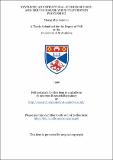Files in this item
Synthetic and structural studies of foot-and-mouth disease virus polyprotein processing
Item metadata
| dc.contributor.advisor | Gani, D. (David) | |
| dc.contributor.author | Lenman, Morag May | |
| dc.coverage.spatial | 176 p. | en_US |
| dc.date.accessioned | 2018-07-16T14:57:40Z | |
| dc.date.available | 2018-07-16T14:57:40Z | |
| dc.date.issued | 1996 | |
| dc.identifier.uri | https://hdl.handle.net/10023/15436 | |
| dc.description.abstract | The 2A region of the foot-and-mouth disease virus (FMDV) polyprotein is only 16 amino acids in length. During synthesis of the FMDV polyprotein, a primary proteolytic processing event occurs between the 2A and 2B regions of the polyprotein at a Gly-Pro junction. Since the 2A region is too small to be an enzyme, and there is evidence to rule out host protease involvement, it is proposed that the 2A segment represents a self-cleaving system. Synthetic oligopeptides containing the 2A sequence have been prepared using solid phase peptide synthesis and their three-dimensional structures in different solvents have been investigated, using NMR and CD techniques. Computer modelling studies of the 2A region have been carried out and have indicated the presence of a cis prolyl bond. Short peptide fragments containing the sequence of the 2A region around the scissile bond have also been prepared by solution phase peptide synthesis and their conformations examined, using NMR spectroscopy. In particular, the NPGP tetrapeptide, which is alleged to possess cleavage activity was prepared and its reactivity investigated. The influence of prolyl cis/trans isomerism on the structure of polypeptides is poorly understood and a synthetic approach has been used to prepare cis X-Pro peptides. The strategy involved the formation of bicyclic compounds containing a hydrazide linkage with a view to breaking the N-N bond under mild conditions to give the natural cis X-Pro peptide. The design, synthesis and reactivity of various novel, bicyclic cis X-Pro dipeptides is described. These compounds represent a new class of type VI beta-turn mimetics and as it has been shown that they can be easily extended at the amino and carboxy termini for incorporation into larger peptides. X-ray crystal structures for some of the compounds and intermediates are presented. Investigations into the reductive cleavage of these compounds were carried out and some were found to display unusual reactivity with the chosen reduction method. In particular, a novel intramolecular transamidation reaction is reported and its mechanism has been investigated by the use of various substituted derivatives. | en_US |
| dc.language.iso | en | en_US |
| dc.publisher | University of St Andrews | |
| dc.subject.lcc | QD431.7L3 | |
| dc.title | Synthetic and structural studies of foot-and-mouth disease virus polyprotein processing | en_US |
| dc.type | Thesis | en_US |
| dc.type.qualificationlevel | Doctoral | en_US |
| dc.type.qualificationname | PhD Doctor of Philosophy | en_US |
| dc.publisher.institution | The University of St Andrews | en_US |
This item appears in the following Collection(s)
Items in the St Andrews Research Repository are protected by copyright, with all rights reserved, unless otherwise indicated.

